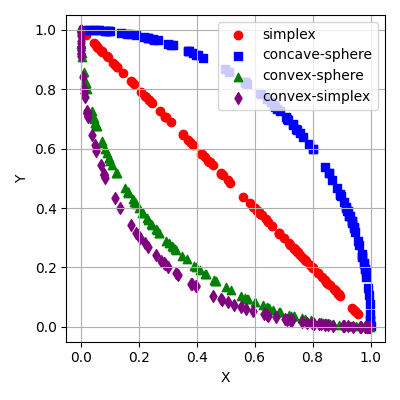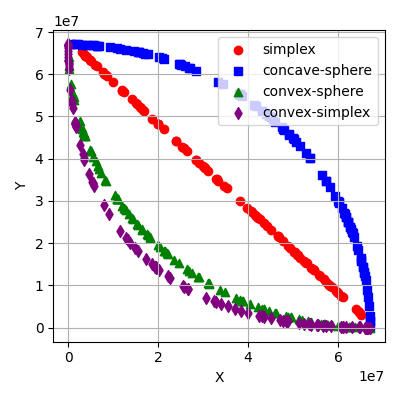Note
Go to the end to download the full example code.
Sampling Random Nondominated Sets#
This example illustrates how to sample random sets with mutually nondominated points.
First we define a few functions useful for plotting.
import moocore
import numpy as np
import matplotlib.pyplot as plt
import plotly.graph_objects as go
from plotly.subplots import make_subplots
def plot_3d(what, x, title, plotly=False):
"""Scatter plot of 3D points."""
if not plotly:
fig = plt.figure()
ax = fig.add_subplot(projection="3d")
match what:
case "simplex":
# Standard 2-simplex vertices in 3D
x_s, y_s, z_s = np.eye(3, dtype=int)
if plotly:
surface = go.Mesh3d(
x=x_s,
y=y_s,
z=z_s,
i=[0],
j=[1],
k=[2],
color="cyan",
opacity=0.2,
flatshading=True,
name="Simplex",
hoverinfo="none",
)
else:
ax.plot_trisurf(
x_s,
y_s,
z_s,
triangles=[[0, 1, 2]],
color="cyan",
alpha=0.2,
edgecolor="gray",
)
case "concave" | "convex":
# Generate points on the positive orthant of the sphere.
phi = np.linspace(0, np.pi / 2, 50)
theta = np.linspace(0, np.pi / 2, 50)
phi, theta = np.meshgrid(phi, theta)
# Convert spherical to Cartesian coordinates (unit sphere)
x_s = np.sin(phi) * np.cos(theta)
y_s = np.sin(phi) * np.sin(theta)
z_s = np.cos(phi)
if what == "convex":
x_s = 1 - x_s
y_s = 1 - y_s
z_s = 1 - z_s
if plotly:
surface = go.Surface(
x=x_s,
y=y_s,
z=z_s,
colorscale=[[0, "cyan"], [1, "cyan"]],
opacity=0.2,
showscale=False,
name="Surface",
)
else:
ax.plot_surface(
x_s, y_s, z_s, color="cyan", alpha=0.2, edgecolor="gray"
)
case _:
raise ValueError(f"Unknown plot type {what}")
if plotly:
scatter = go.Scatter3d(
x=x[:, 0],
y=x[:, 1],
z=x[:, 2],
mode="markers",
marker=dict(size=2, color="blue"),
)
layout = go.Layout(
title=title,
scene=dict(
xaxis=dict(title="X", range=[0, 1]),
yaxis=dict(title="Y", range=[0, 1]),
zaxis=dict(title="Z", range=[0, 1]),
# Approx. elev=30, azim=25
camera=dict(eye=dict(x=1.2, y=1.2, z=0.8)),
),
margin=dict(l=0, r=0, b=0, t=40),
showlegend=False,
)
fig = go.Figure(data=[surface, scatter], layout=layout)
else:
ax.scatter(
x[:, 0],
x[:, 1],
x[:, 2],
color="blue",
s=20,
marker="o",
depthshade=False,
)
ax.set(
xlabel="X",
ylabel="Y",
zlabel="Z",
xlim=(0, 1),
ylim=(0, 1),
zlim=(0, 1),
title=title,
)
ax.view_init(elev=30, azim=25)
return fig
def plotly_3d(what, x, title):
"""Scatter plot of 3D points using plotly."""
return plot_3d(what=what, x=x, title=title, plotly=True)
def plotly_3d_side_by_side(fig1, fig2):
"""Show two plotly 3D figures side-by-side."""
fig = make_subplots(
rows=1,
cols=2,
specs=[[{"type": "scene"}, {"type": "scene"}]],
subplot_titles=(fig1.layout.title.text, fig2.layout.title.text),
)
fig.add_traces(
fig1.data,
rows=[1] * len(fig1.data),
cols=[1] * len(fig1.data),
)
fig.add_traces(
fig2.data,
rows=[1] * len(fig2.data),
cols=[2] * len(fig2.data),
)
fig.update_layout(
height=400, title="", margin=dict(l=0, r=0, b=0, t=40), showlegend=False
)
fig.update_scenes(fig1.layout.scene.to_plotly_json())
return fig
Random nondominated sets in 2D#
n = 100
rng = np.random.default_rng(42)
methods = ["simplex", "concave-sphere", "convex-sphere", "convex-simplex"]
colors = ["red", "blue", "green", "purple"]
markers = ["o", "s", "^", "d"] # circle, square, triangle_up, diamond
plt.figure(figsize=(4, 4))
for i, method in enumerate(methods):
points = moocore.generate_ndset(n, 2, method, seed=rng)
plt.scatter(
points[:, 0],
points[:, 1],
color=colors[i],
marker=markers[i],
label=method,
)
plt.xlabel("X")
plt.ylabel("Y")
plt.legend()
plt.tight_layout()
plt.grid(True)
plt.show()

Random nondominated sets in integer space#
We can also generate points in integer space.
n = 100
rng = np.random.default_rng(42)
maximum = 0
points = []
for method in methods:
x = moocore.generate_ndset(n, 2, method, seed=rng, integer=True)
points += [x]
maximum = max(maximum, x.max())
plt.figure(figsize=(4, 4))
for i, method in enumerate(methods):
x = points[i]
# Normalise so we can plot all sets within the same range.
if x.max() < maximum:
x = moocore.normalise(x, lower=0, upper=x.max(), to_range=(0, maximum))
plt.scatter(
x[:, 0], x[:, 1], color=colors[i], marker=markers[i], label=method
)
plt.xlabel("X")
plt.ylabel("Y")
plt.legend()
plt.tight_layout()
plt.grid(True)
plt.show()

Variants of convex nondominated sets#
A popular way to generate a convex nondominated set is to translate the
negative orthant of the hyper-sphere to the unit hyper-cube
(convex-sphere). However, there are other possible convex sets with
different properties. For example the method convex-simplex applies a
non-linear transformation to a concave-sphere set, resulting in a convex
transformation of the standard simplex.
n = 2000
rng = np.random.default_rng(42)
points = moocore.generate_ndset(n, 3, "convex-sphere", seed=rng)
fig1 = plotly_3d("simplex", points, title="Convex-sphere")
points = moocore.generate_ndset(n, 3, "convex-simplex", seed=rng)
fig2 = plotly_3d("simplex", points, title="Convex-simplex")
plotly_3d_side_by_side(fig1, fig2)
Uniform sampling (moocore) vs projections of uniform samples (naive)#
Naive methods for sampling such sets usually sample points uniformly in the hypercube and project them into a lower dimensional manifold 13, e.g., the standard simplex or the positive orthant of the hypersphere. However, such projections do not preserve the uniformity of the sampling, that is, not all points in the manifold have the same probability of being sampled.
The function generate_ndset() produces a uniform sampling
on the manifold, as shown in the following examples:
n = 2000
rng = np.random.default_rng(42)
points = moocore.generate_ndset(n, 3, "simplex", seed=rng)
fig1 = plotly_3d("simplex", points, title="Simplex (moocore)")
points = rng.uniform(size=(n, 3))
points /= points.sum(axis=1, keepdims=True)
fig2 = plotly_3d("simplex", points, title="Simplex (naive)")
plotly_3d_side_by_side(fig1, fig2)
points = moocore.generate_ndset(n, 3, "concave-sphere", seed=rng)
fig1 = plotly_3d("concave", points, title="Concave-sphere (moocore)")
points = rng.uniform(size=(n, 3))
points /= np.linalg.norm(points, axis=1, keepdims=True)
fig2 = plotly_3d("concave", points, title="Concave-sphere (naive)")
plotly_3d_side_by_side(fig1, fig2)
points = moocore.generate_ndset(n, 3, "convex-sphere", seed=rng)
fig1 = plotly_3d("convex", points, title="Convex-sphere (moocore)")
points = rng.uniform(size=(n, 3))
points /= np.linalg.norm(points, axis=1, keepdims=True)
fig2 = plotly_3d("convex", 1.0 - points, title="Convex-sphere (naive)")
plotly_3d_side_by_side(fig1, fig2)
Total running time of the script: (0 minutes 0.705 seconds)